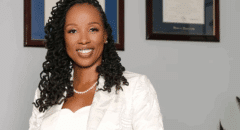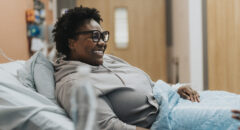
Each year as we approach October the fever starts to erupt. By October, it reaches a fever pitch. I'm talking about the fever surrounding breast cancer awareness. Everyone wears pink. The grocery store shelves are filled with items manufactured by companies that pledge funds towards breast cancer research.
Even our football stars, America's modern-day gladiators, don pink in honor of Breast Cancer Awareness Month. It's at this time that we become most aware of the impact breast cancer has had among us. According to a 2015 report, Black women have nearly twice the rate of triple negative breast cancer - the deadliest form, as white women and we have the highest mortality rate from any form of breast cancer. That means that when you look around, many of the women you know and love will be impacted by breast cancer.
But what happens after October is what's most important.
As a gynecologist, I see scores of women weekly, who when asked about doing regular self- breast exams, either look down in shame or willingly admit that they have not done their part in monitoring themselves for early signs of breast cancer.
So let me take this opportunity to remind us all that one in seven women will be diagnosed with breast cancer. That equates to over 220,000 women per year. It is associated with obesity, high-fat diet, sedentary life style, alcohol consumption, and can be increased if you have a genetic mutation (BRCA, which by the way, is more common in Black women and can be detected with a blood test-speak to your provider). There are clearly environmental contributors to the above-stated risks although these are hard to quantify.
Do not feel reassured enough to discontinue or forego monitoring in the absence of family history because only 10% of breast cancers are found in those with family history, i .e. the overwhelming majority of cases are found in those with no family history.
The best way for us to continue to see declining death rates of Black women from this disease is to accept individual responsibility. Follow these three simple steps:1. See a health care provider annually for a wellness check so that you can have a trained professional examine your breasts.
My group practice, Innovative Women's Health Care Solutions, offers free breast exams throughout the month of October. Additionally, through our outreach arm, Innovative In Action, we perform free breast exams in collaboration with the YMCA and St. Joseph's-Emory mobile unit in Atlanta. Check with your provider and local agencies about free exams.
2. Get your mammograms!
No excuses ladies, as there are free and low -cost mammograms available in most areas of the country.
3. Last and most important, you must perform monthly breast exams.
Your provider exam and your mammogram are only done at one point in time. You have eleven additional months that you must take care of yourself. If you don't feel for it, you won't find it, thus you won't report it and we will not be able to evaluate it. Therefore, the diagnosis will not be made. Here is how to do a simple self exam.
A later diagnosis decreases your options, increases your need for major surgery, need for chemotherapy and lessens your chances for survival.
I do understand you are busy, so here are some ways to help you remember to practice self care:
- Find a bosom buddy. This is the person, possibly your BFF, who will remind and lovingly scold/shame you into doing your self breast exam. You should do the same for her.
- Delegate examinations to your partner. They will find it a fun exercise!
- Use that wonderful device you have called a smartphone to remind you monthly.
Let's not just get swept up in the fever. Let's continue to sweat it out throughout the upcoming year.









